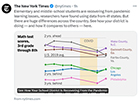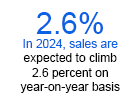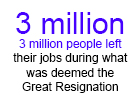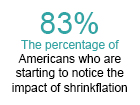
By Staff
Wednesday, April 3, 2024 11:55 AM
A formula shortage in 2022 had parents scrambling to find alternative options for their babies. In 2022, a formula shortage due to the pandemic, product recalls and supply chain issues left grocery store shelves bare and parents in search of infant formula.
A
new report from the U.S. Census Bureau finds that more than 57.5 percent of parents had to switch stores in order to find baby formula in the fall of 2022, falling slightly to 57 percent by the summer of 2023.
More than 20 percent of parents reported they were having a hard time finding formula in the summer of 2023, an improvement of more than 14 percentage points over the fall of 2022.
The Census Bureau report found that between the dates of September 14 and October 17 in the fall of 2022, parents of infants or babies under 1 year were asked how they were coping with the shortage. More than 34 percent said they had difficulty getting formula during the previous seven days. By the summer of 2023, this number had fallen to just below 20 percent, signaling that the pandemic was no longer having the same impact on formula availability.
Many parents reported they dealt with the shortfall by changing shopping behaviors, such as changing brands or types of formula. More than 55 percent of parents had changed formulas by the fall of 2022, improving to 44 percent by the summer of 2023.
More than 32 percent of parents indicated that they had dealt with the shortage by receiving formula from family and friends, or “others.”

By Staff
Tuesday, April 2, 2024 2:29 PM
Americans are ready to return to the friendly skies. A
new report from the Airport Councils International (ACI) indicates that global passenger travel will surpass 2019 levels in 2024, reaching more than 9.7 billion travelers.
The increase is expected to be short-lived and will taper off over the next few years as markets recover from the impact of the pandemic. The ACI reported that macroeconomic factors, such as high global inflation, slowdown of global GDP, pessimistic business confidence levels and geopolitical conflicts continue to pose a risk to the recovery of air travel.
Several regions are expected to see a significant influx in travel, including Africa where passenger rates are expected to grow from 219 million in 2013 to 242 million in 2024. It’s predicted it will grow even further in 2025 to 261 million.
The North American region will have modest growth reaching 2.2 billion in 2024 with a small increase to 2.3 billion in 2025. This would be on par with pre-pandemic growth figures.
The Middle East is expected to see modest growth over the next few years, climbing to 466 million in 2024 and 510 million in 2025; however, the ACI noted that geopolitical tension in the region could significantly affect these projections.
Global passenger traffic is expected to grow at a rate of 4.3 percent over the next three years. Total passenger traffic could reach 25 billion by 2052.

By Staff
Friday, March 29, 2024 1:52 PM
Baseball season is in full swing, and experts are predicting a resurgence in attendance in 2024. Recent years saw attendance numbers slip due to the pandemic and the cancellation of games.
In 2023, regular season attendance reached more than 70 million for the first time since 2017, according to
Major League Baseball (MLB). Prior to the pandemic, regular season attendance had been on the decline, falling to just over 69 million in 2018. By 2019, it had fallen to 68.5 million, and it slipped again in 2022 to 64.5 million. The 2020 and 2021 seasons saw dozens of games canceled, along with some teams unable to travel due to players’ illness and COVID restrictions.
Several
new rules are slated for the 2024 season, including the widening of the runners' lane to include the dirt between the foul line and the infield grass. This will provide a more direct path from the right-handed batter’s box to first base.
Pitch times have also been adjusted from 20 seconds to 18 seconds with runners on base. Meanwhile, mound visits will be reduced from five to four times in a game.

By Staff
Thursday, February 1, 2024 3:23 PM
Elementary and middle-school students are recovering from
pandemic learning losses, researchers have found using data from 41 states. But there are huge differences across the country. Head over to
The New York Times to find out more.

By Staff
Friday, January 5, 2024 2:33 PM
Light vehicle sales are on the rise, following three years of decline. A
new report from Statista predicts sales to increase by 7.7 percent by the end of 2023. Further growth is expected into 2024, with sales expected to climb 2.6 percent year-on-year.
The COVID-19 pandemic put significant pressure on the auto industry, causing a drop in sales, supply chain issues and chip shortages. The industry continues to undergo a slow recovery, with sales once again on the rise.
Global sales of light vehicles had contracted by 0.6 percent in 2022 due to the influence of the pandemic.
ING, a Dutch multinational banking and financial services corporation, is
predicting a 2 percent to 3 percent growth by the end of 2024, with automakers in China, the U.S. and Europe seeing the greatest increase.
The corporation also believes that electrification of the auto industry will drive sales in a new direction, with more countries adopting an all-electric vehicle policy over the next 10 to 20 years. China has already seen its electric car sales grow by more than 30 percent in 2023. Meanwhile, electric vehicle and hybrid vehicle sales now make up 23 percent of car sales in Europe.
The U.S. has been slower to adopt electric vehicles. Overall sales remain at less than 10 percent but are slowly increasing.

By Staff
Thursday, November 16, 2023 2:22 PM
The National Retail Federation forecast that holiday spending is expected to reach record levels during November and December and will grow between 3 percent and 4 percent over 2022 to between $957.3 billion and $966.6 billion. “It is not surprising to see holiday sales growth returning to pre-pandemic levels,” NRF president and CEO Matthew Shay said. “Overall household finances remain in good shape and will continue to support the consumer’s ability to spend.”
Despite a slower growth rate compared with the past three years, when trillions of dollars of stimulus led to unprecedented rates of retail spending during the pandemic, this year’s holiday spending is consistent with the average annual holiday increase of 3.6 percent from 2010 to 2019.
Online shopping has been one of the biggest shifts in consumer behavior from the COVID-19 pandemic. Online and other non-store sales, which are included in the total, are expected to increase between 7 percent and 9 percent to a total of between $273.7 billion and $278.8 billion. That figure is up from $255.8 billion last year.

By Staff
Monday, October 9, 2023 12:04 PM
Despite easing pandemic fear, labor shortages remain a concern for U.S. employers. A new report from the
U.S. Chamber of Commerce finds that job openings are beginning to increase across the nation, however the number of people in the labor force continues to fall.
During the pandemic, more than 30 million people were unemployed. Since the end of the pandemic, more than 4.5 million jobs have been added to the workforce. This has not been enough to restore the labor force, with approximately 1.4 million fewer Americans working compared to February 2020.
The labor force participation rate has fallen from 63 percent in February 2020 to 62.8 percent. Many workers are reprioritizing with 27 percent reporting they need to focus on home and childcare, making returning to work difficult. An additional 28 percent have reported that illness and poor health is making it hard to return to work. The labor shortage has also been driven by more than 3 million adults leaving the workforce due to retirement. Between Q3 2019 and Q3 2021 the number of adults over 55 who left the workforce rose from 48 percent to 50 percent.
Many families cited lack of access to childcare as a reason for remaining out of the workforce. Meanwhile, more than 3 million people left their jobs during what was deemed the Great Resignation, however hiring has been able to outpace quitting. Experts at the Chamber of Commerce believe the next step in addressing the labor shortage is to implement solutions to attract and retain new workers.

By Staff
Wednesday, September 13, 2023 9:00 AM
The lingering impact of inflation and COVID has made consumers even more value-conscious and discerning about their holiday shopping experience.

By Staff
Thursday, August 10, 2023 12:01 PM
More than ever, customers demand—and deserve—efficiency, flexibility, timeliness, value, and priority.

By Staff
Tuesday, July 18, 2023 4:07 PM
The U.S. has reached a milestone in the
long struggle against COVID—the total number of Americans dying each day, from any cause, is no longer historically abnormal. Head over to
The New York Times to find out where we stand when it comes to COVID statistics in the U.S.

By Staff
Monday, July 17, 2023 3:23 PM
The number of Americans getting plastic surgery is on the rise. According to a new report from the International Society of Aesthetic Plastic Surgery (ISAPS) titled,
Global Survey on Aesthetic/Cosmetic Procedures, the number of people getting plastic surgery rose by more than 19 percent in 2021.
The survey found that nearly 13 million people had surgical plastic surgery procedures and 17.5 million had non-surgical procedures worldwide. These figures indicate that COVID-19 is no longer slowing down the cosmetic procedure industry, which saw a decrease in procedures during the pandemic by 1.8 percent for all procedures and nearly 11 percent for surgical procedures.
The U.S. saw the greatest increase in procedures, rising 24 percent, with 30 percent of all non-surgical procedures and 15.5 percent of all surgical procedures. Brazil came in second at 8.9 percent followed by Japan at 5.7 percent.

By Staff
Wednesday, July 12, 2023 12:24 AM
NEW YORK—The adoption of telemedicine has shown an increase in eyecare, particularly during the COVID-19 pandemic.
Jobson Research’s latest report, titled Telemedicine Research - Updated April 2023, focuses on the integration of telemedicine into contact lens care, summarizing recent survey data to provide insights into the current state of telemedicine usage as well as practitioners’ perspectives on the feasibility of adopting telemedicine as a vision care tool. This data is derived from a survey of eyecare professionals distributed by Jobson Medical Information in 2023. The survey was created by John D. Gelles, OD, FAAO, FIAOMC, FCLSA, FSLS, FBCLA and Jennifer Waller, director of research & business analytics for Jobson Research. The survey was sent to Jobson’s email list of eyecare professionals. Only optometrists and ophthalmologists were qualified to take the survey.

By Staff
Tuesday, June 27, 2023 4:05 PM
The big picture for the Fed is that inflation fears are receding, but not back to where they were prior to the pandemic.

By Staff
Wednesday, June 21, 2023 3:43 PM
Consumer spending is on the rise, triggering an influx in maritime transport, according to the findings of a new report from the
United Nations Conference on Trade and Development. Online orders have been the driving force behind consumer spending, leading to an increase in container shipping costs and the price of consumer goods.
Increases have also been seen among raw materials such as grain due to the war in Ukraine and prolonged effects from the pandemic. This, paired with supply chain issues, has driven consumer food prices up 1.2 percent, particularly in middle and low income countries.
The UNCTAD projects a decrease in growth to 1.4 percent, however between 2023 and 2027, growth is expected to reach 2.1 percent annually, slightly down than the 3.3 percent average over the past 30 years.

By Staff
Wednesday, June 14, 2023 2:54 PM
Americans are more aware of shrinkflation and are feeling the pinch. These are the findings in a new poll from
Ipsos Consumer Tracker. The report found that 83 percent of Americans are starting to notice the impact of shrinkflation on the products they purchase. Shrinkflation occurs when a company decreases the size of a product while maintaining or raising the price.
As a result, 79 percent of Americans report feeling cheated as a result of shrinkflation. Americans are also discovering that the savings they accumulated during COVID is no longer the case, with only 37 percent saying they saved enough.
The level of empathy for small businesses who have raised their prices has increased at a rate of 84 percent, while empathy for large global companies fell to 35 percent.